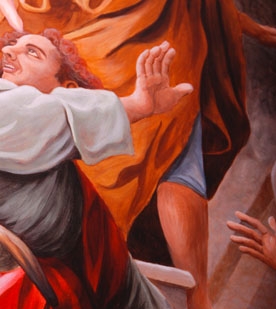This reproduction of French artist Jean Restout’s 1732 painting tells the story of Acts 2:1-4. Mary and the 11 apostles along with other disciples are in Jerusalem 50 days after Jesus’s death, hiding in “the upper room”, fearing their own persecution and death. A strong, driving wind comes and then tongues of fire descend upon them, and they are filled with the Holy Spirit and with courage to go out and preach the good news.
I don't know for certain who Restout intended each figure in the painting to represent, but this is what I decided for mine... starting with Mary at 12:00 and going clockwise to Thomas, Mary Magdalene, Mary Clopas (the mother of Simon & Jude), Matthias or Philip, Peter (the first out the door to preach), Bartholomew, John (with his head down), Jude, Simon, Matthew, Andrew (above), and Mary & Martha, with James the Great between them.
Explanation of Symbols:
- Tongues of fire = Holy Spirit, heavenly power
- Altar = Mary and the disciples offer all that they are to God
- Pillars = strength; structure of the Church, which is built on these disciples
- People of different races and ages = the people in Restout’s original all look caucasian. It’s common for artists to show their subjects in their own race (i.e. Japanese Jesuses, Black Madonnas, etc.); some of the figures in this mural were changed (in race or age) to reflect the diversity of the parish population.
- Hands at the far left and right of people otherwise unseen = to represent any one of us.
When painting this reproduction of Jean Restout's "The Pentecost", I noticed he'd hidden a lot of secret or subliminal images in his work. Shapes of doves in the clouds may represent the Holy Spirit. I also saw five different “ghosts” or hidden figures in the shadows, sky and stone. Do they represent the presence of past or future members of the Church, or maybe demons/fears/worries that the Holy Spirit empowers us to put down, or something else?
The first and most obvious "ghost" is behind Martha. It might be a statue, or an angel... I don't know.
The second "ghost" I noticed in Restout's painting is in the stone altar above St. John. Just to the left of the column on the far right, look in the corner of the groove before it becomes brick.
There is also something on the front of the altar that I couldn't figure out at first, so I just painted the lights and darks as closely as I could to his without knowing what they'd become. After I was finished I could see a cross and curved rays, which could represent Christ as foundation, rock, and sacrifice.
I think it is St. John kneeling because he is young (no greys), and I can see a bird head in the folds of his green cloak, at the bend of his elbow. The eagle is St. John's symbol. I can also see a heart in the folds right above the back of his neck. St. John is often referred to as "the beloved disciple."
Below is St. Andrew. Why? Because AFTER I had it painted, I could find all the letters to spell out "Andrew" in the highlighted folds of his cloak. (The R might be a bit of a stretch.)
Another of the "ghosts" appears in the shadows beneath Andrew's left hand. This is not as friendly of a face, and to me looks like some demon or fear that Andrew is now empowered to put down.
The fourth "ghost" is on the far right, in the highlights of the stone. Look halfway between St. Peter's hand (above) and the hand coming in from the right side (below). This ghost looks almost childlike, and more worried than angry or scary.
The fifth "ghost" is in the sky just above Mary Clopas's lower hand.






